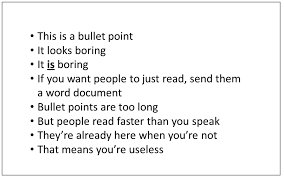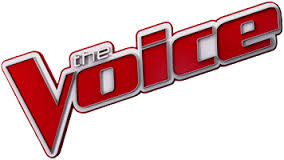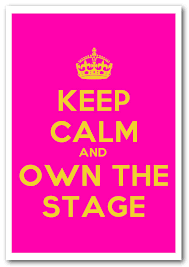 In our over-conferenced world these facts are undeniable: If your presentation doesn’t impress, you won’t be invited back, you won’t be asked to speak elsewhere, and you will have wasted a lot of time and money traveling and stressing about delivering a talk that failed to engage anyone’s attention.
In our over-conferenced world these facts are undeniable: If your presentation doesn’t impress, you won’t be invited back, you won’t be asked to speak elsewhere, and you will have wasted a lot of time and money traveling and stressing about delivering a talk that failed to engage anyone’s attention.
This post offers 8 ways to slay an audience of any size, be it 1 person or 1,000. If you can master some of these techniques you’ll lead the pack for the simple reason that your fellow speakers haven’t even thought of them. Yes, it requires extra effort but it’s worth it, especially if you want to be memorable.
#1 Surprise
The s-word — “surprise” – is the most overlooked virtue of any presentation. Put it to work. Don’t tell them what they already know — that’s so dull and, in a way patronizing, as it underestimates what they already know. Oh, and how to assess the level of your audience’s knowledge? Ask the organizers who’ll be in attendance or take a few minutes to cruise some of their profiles on LinkedIn.
A few ways to add surprise:
Present counterintuitive or contradictory ideas.
Begin in one place but end up somewhere completely different.
Use an unexpected prop.
One client had invented a complex medical device that was the size of a Sonos speaker and fits neatly on a kitchen counter. Getting the device to be this compact was no small feat of engineering. To create that element of surprise, he entered the stage pushing a gigantic a box the size of a Subzero refrigerator on wheels. After recounting the story and struggles to get this device from concept to fruition it came time for the reveal. He opened the massive box and pulled out his compact device and held it in the palm of his hand. The room gasped. His presentation gave the audience what it needed but not what it expected. The investors responded, giving him what he needed in return. 🙂
#2 Be human and authentic in your presentations
Rather than adding more slides with yet more data and charts, tell a story. Turn a dull list of information into a problem-struggle-solution narrative. It’s easy to do and applies to so many business presentations. Storytelling is so crucial to powerful presentations that we make it a priority in all our business workshops.
 When we first met, the inventor of the medical device in the previous entry began his presentation with a long treatise on the nature of the disease and followed that with another explanation of how various molecules in certain medicines fight the symptoms. This college lecture went on for a loooooong and very unthrilling 2 minutes.
When we first met, the inventor of the medical device in the previous entry began his presentation with a long treatise on the nature of the disease and followed that with another explanation of how various molecules in certain medicines fight the symptoms. This college lecture went on for a loooooong and very unthrilling 2 minutes.
I encouraged him to start from a new place, such as how he discovered the problem he was trying to solve. He told me about his dog’s bout with this illness and how it inspired him to come up with a new approach to treatment. I asked the dog’s name and he told me that Numi wasn’t only his dog, but his best friend, which is why he went to such lengths to save his life.
I insisted that a close-up shot of Numi become his first slide.
“To a room of venture capitalists?”
“Exactly! They’ve just spent two days in an airless room being subjected to slides and graphs — information. If you tell them your story and make it real by presenting a character (with a name), you’ll stand out. They’ll remember the telling details you drop and, if nothing else, they’ll remember you as the guy who had the guts to start his presentation with a pic of a four-legged friend. You’ll be a sort of hero.
“Besides, any serious investor will ask for detailed financials and your business plan to review later. The point of this presentation is to get them eager to know more.”
His invention was great and he had the room eating from his hand. Someone told him he was the ‘Steve Jobs of the day.’ He closed his funding round the next morning.
#3 Don’t show it before you say it!
When it comes to slides: Don’t allow the audience to read it before you say it.
Why? The eyes absorb so much faster than the ears.
If you use a slide with 10 bullet points I guarantee they’ll have scanned and absorbed all ten points by the time you’re still warbling through point one.
They’ll be bored and they’ll tune you out or revert to their phones.
Taking the focus off yourself while on stage is a fatal error and almost everyone does it.
And by the way: slides with 10 bullet points?
No way. Ever! It’s too dense to read. If you must use bullet points, use dynamic slides that scroll one point at a time.
The following basics, which come courtesy of graphic designer Garr Reynolds, (that’s another point in creating good presentations, give credit when credit is due!) are useful for creating Insta-Gets. Don’t focus on the aesthetics here. Just remember: Graphics that won’t strain the eyes of your audience make the point.
High Impact Charts
If making a pie chart, highlight the most important points with color or exploding slices. Limit the number of slices to 6.
Tables tend to lack impact. They’re dull and don’t draw focus.
Instead, use bar charts to show changes over time. Limit the number of bars to 8.
Horizontal bars work well in comparisons.
If using line charts, illustrate the upward or downward trend with a big arrow. You can easily speak to nuance or detail without competing with a slide like this!
#4 Your most undervalued resource: your voice
A simple fact: If your voi ce is flat your presentation will not sound energetic, you will not sound vital and people will tune you out.
ce is flat your presentation will not sound energetic, you will not sound vital and people will tune you out.
You own this instrument so why not put it to use? A good way to explore the power of vocal variation is to play with word emphasis. What words can you accentuate to spark up the power of your content? How can you raise or lower your volume to draw people in? Those two areas require some exploratory work, but one thing you can do instantly is to raise your volume 20%. That slight shift of volume will help you sound more energized.
To explore vocal modulation, try this simple exercise below when you’re next alone. Read the following sentences aloud emphasizing the words in boldface. Doing this purposefully requires practice but you will quickly see how placing the emphasis differently changes the meaning and impact of your words.
VOCAL MODULATION
| Mary had a little lamb | Mary, not Tom, had the lamb |
| Mary had a little lamb | She had it once, but no longer |
| Mary had a little lamb | She had one, not two, lambs |
| Mary had a little lamb | The lamb was little, not big |
| Mary had a little lamb | A lamb, not a sheep |
#5 Move your body!
 You don’t need to do contortions, but moving purposefully on stage accomplishes several things:
You don’t need to do contortions, but moving purposefully on stage accomplishes several things:
- It changes the energy in a room, which is a good thing after an audience has been listening to you for over 10 minutes.
- It signals that you are changing topic or tack, so pay attention!
- And it demonstrates your confidence, whether you have the confidence or not. Remember, speakers who are nervous or unprepared or just starting out are usually too busy worrying about perspiring or remembering their scripts to think about elevating their stage presence. Using the stage typically stands you heads above the competition.
The best way to explore moving on stage is to start small and limit your range to what we call the Triangle of Power. (Note: when first trying this, write the stage directions into your script.) Basically there are three routes you can take.
- Across. Move from one fixed point to another across the stage. Think of this as a section break in a magazine article — it signals a change of topic. Keep the movement simple and calm. You don’t have to walk miles. And don’t charge from one point to another. A few calm steps will do. When you land at your designated point, take a pause and settle before speaking again.
- Forward. When delivering a key point, go forward, as close to the audience as possible. Breaking the imaginary Maginot line that separates the speaker from the audience is powerful and wakes up the audience. Think of this as the underscore.
- Lean In. This works in a smaller setting like a conference or board room. When you’re about to make your point, leaning forward and planting your fingertips lightly on the table drives the message home.
#6 Open with a bang!
 Four alternatives to the same old, same old.
Four alternatives to the same old, same old.
Starting strong is always useful, if for no other reason to get the audience away from those weapons of mass distraction: their smartphones. We live in an over-conferenced world so I encourage you to experiment with less predictable ways of launching.
If you are a conference junkie you’ll know that posing a question has become cliché, unless of course, it is a provocative or timely question that perfectly encapsulates your topic. There are other equally effective ways to launch.
What not to do:
- Don’t reintroduce yourself and thank the hosts. Your name is on the program or the slide behind you. No one attending is attending by accident. Do the formalities after you’ve grabbed them.
- Don’t have a video or audio that eight times out of ten doesn’t work on cue. Begin this way at your own risk.
- Don’t try to be funny. If you’re not naturally funny it will fail. It’s hard to be funny. Instead, find the traits that you do best and emphasize them.
What to do:
Take a poll
- Thumbs up, stand up, or show of hands. (Bonus: it gets them to put down their phones.)
- Example: “Raise your hand if you think it’s possible to control someone’s attention?”
Offer a surprising or counterintuitive fact
- “I don’t want to alarm anybody in this room, but it’s just come to my attention that the person to your right is a liar.”
- “Today I want to discuss why you’re going to fail to have a great career.”
- “Did you know that more people in the world have access to a mobile phone than a toilet?”
Close your eyes and imagine (a fresh way of opening that is not used often)
- “Close your eyes and imagine waking up in a 13th-century home built into the side of a mountain, stone floor, a roaring fireplace and a steaming mug of coffee on the table before you’ve gotten out of bed…
Personal Revelation
- “I need to make a confession. A little over 20 years ago I did something that I regret, something that I’m not particularly proud of. Something that, in many ways, I wish no one would ever know, but that I feel obliged to reveal.”
Bottom line: Don’t be afraid to provoke from the get-go. State an opinion or a point of view and then make sure your presentation backs it up. If it’s controversial, good, but be prepared for pushback. A little friendly fire is the mark of an engaged audience.
#7 End strong
Wrap up your presentation with some action the audience can take right then and there to improve their lives or solve a problem. If your presentation is powerful, people will be fired up to take immediate action.
The Rule of Three. A series of three elements is a well-known feature of public oratory and a proven way of being memorable. Here are a few ways that some historical greats have deployed this technique:
“Veni, Vidi, Vici.” (“I came, I saw, I conquered.”) Julius Caesar.
“There are three kinds of lies: lies, damned lies, and statistics.” Benjamin Disraeli
“A Mars a day helps you to work, rest, and play.” Ad slogan for the candy bar.
Close the loop. If you began with a story, conclude it here. If you open with a powerful image, flash it again as a signal to the audience that the talk is coming to a close. Or, if you open by stating a problem, come back to it at the close.
Another reason to finish powerfully: The audience should feel you are energized and ready to take their questions. And in the unlikely event that no one pipes up, come prepared to ask them a question. You can then direct them to discuss the answer with the person seated next to them. Get some of them to share what their neighbor said.
When you are finally finished, do not run off the stage. Stand there for a few seconds and bask in the glory. You did it!
#8 Win the audience
Don’t recycle hackneyed ideas but do feel free to steal from the web before you start. See what’s been done. Evaluate what’s dull vs. what makes your pulse race and use that as a starting point for riffing. The world is awash in content, so slice it, dice it and allow it to stimulate your thinking. If you do borrow, credit your sources. (Thanks to Rand Fishkin for inspiring this blog post. Your blog is awesome and I hope to meet you in person one day).
- Don’t fear your quirks (unless they create so much static that the audience focuses only on them and not on you). Quirks are memorable and can telescope your humanity to the audience. This often works to get them on your side.
- Speak in plain English. Simple (not stupid) is always better than long-winded and academic, but don’t talk down.
- Be smart, but don’t try to be the smartest person in the room. Trying too hard is obnoxious and easily spotted. It will cause the audience to quickly disengage.
- Limit your topic. Don’t overwhelm with too much information. You don’t have to present the entire history of your subject. A small section, thoroughly explored, is preferable.
- Put the audience first. It’s a subtle shift of thinking but once you fully take it on, I guarantee it will lessen your nervousness by putting the focus where it belongs: Off yourself and onto your audience. I rely on this thought when writing and rehearsing every presentation. As one of my mentors, Aristotle, told me: “The audience is the beginning and end of public speaking…It’s all for them, not for you.”






